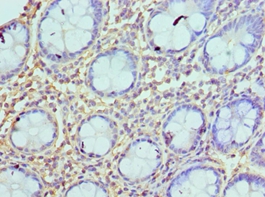This is a neutrophil granule-derived antibacterial and monocyte- and fibroblast-specific chemotactic glycoprotein. Binds heparin. The cytotoxic action is limited to many species of Gram-negative bacteria; this specificity may be explained by a strong affinity of the very basic N-terminal half for the negatively charged lipopolysaccharides that are unique to the Gram-negative bacterial outer envelope. It may play a role in mediating recruitment of monocytes in the second wave of inflammation. Has antibacterial activity against the Gram-nagative bacterium P.aeruginosa, this activity is inhibited by LPS from P.aeruginosa. Acting alone, it does not have antimicrobial activity against the Gram-negative bacteria A.actinomycetemcomitans ATCC 29532, A.actinomycetemcomitans NCTC 9709, A.actinomycetemcomitans FDC-Y4, H.aphrophilus ATCC 13252, E.corrodens ATCC 23834, C.sputigena ATCC 33123, Capnocytophaga sp ATCC 33124, Capnocytophaga sp ATCC 27872 or E.coli ML-35. Has antibacterial activity against C.sputigena ATCC 33123 when acting synergistically with either elastase or cathepsin G.
[1]Atomic resolution structure of human HBP/CAP37/azurocidin."Karlsen S., Iversen L.F., Larsen I.K., Flodgaard H.J., Kastrup J.S.Acta Crystallogr. D 54:598-609(1998). [2]Structure of HBP, a multifunctional protein with a serine proteinase fold."Iversen L.F., Kastrup J.S., Bjoern S.E., Rasmussen P.B., Wiberg F.C., Flodgaard H.J., Larsen I.K.Nat. Struct. Biol. 4:265-268(1997). [3]Initial characterization of the human central proteome."Burkard T.R., Planyavsky M., Kaupe I., Breitwieser F.P., Buerckstuemmer T., Bennett K.L., Superti-Furga G., Colinge J.BMC Syst. Biol. 5:17-17(2011).



